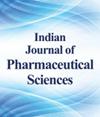Association between Lung Microbiota Dysbiosis and Sepsis Induced Acute Respiratory Distress Syndrome
IF 0.4
4区 医学
Q4 PHARMACOLOGY & PHARMACY
Indian Journal of Pharmaceutical Sciences
Pub Date : 2023-01-01
DOI:10.36468/pharmaceutical-sciences.spl.692
引用次数: 0
Abstract
Ye et al. : Microbiota Dysbiosis in Sepsis Induced Acute Respiratory Distress Syndrome Sepsis is associated with acute respiratory distress syndrome, which has a significant impact on the prognosis of patients. Several studies have shown that the microbiota plays a significant role in sepsis-induced acute respiratory distress syndrome, but the relationship between the microbiota and sepsis-induced acute respiratory distress syndrome is not fully understood. We conducted a case-control and single-center study in 19 sepsis-induced acute respiratory distress syndrome patients and 36 sepsis-non-induced acute respiratory distress syndrome patients to investigate the clinical features and microbiota expression. There were 55 subjects enrolled, 19 of whom suffered acute respiratory distress syndrome due to sepsis. A significant increase in the abundance of Pseudomonas aeruginosa , leptospiral virus, Cytomegalovirus , Klebsiella pneumoniae , Streptococcus pneumoniae , Candida albicans , Escherichia coli , Epstein-Barr virus and Staphylococcus aureus . Besides, expressions of peripheral T lymphocytes (cluster of differentiation 3 + , cluster of differentiation 4 + and cluster of differentiation 3 + , cluster of differentiation 8 + ) was much higher in the sepsis-induced acute respiratory distress syndrome group than that in the sepsis non-induced acute respiratory distress syndrome group. The acute physiology and chronic health evaluation II scores, duration of mechanical ventilation and mortality with 28 d and 90 d were much higher in the sepsis-induced acute respiratory distress syndrome group. Patients with sepsis-induced acute respiratory distress syndrome had worse clinical outcomes and a higher expression of peripheral T lymphocytes, as well as the relative abundance of microbiota dysbiosis.肺微生物群失调与败血症引起的急性呼吸窘迫综合征的关系
脓毒症与急性呼吸窘迫综合征相关,对患者预后有显著影响。多项研究表明微生物群在脓毒症急性呼吸窘迫综合征中起着重要作用,但微生物群与脓毒症急性呼吸窘迫综合征之间的关系尚不完全清楚。我们对19例脓毒症致急性呼吸窘迫综合征患者和36例脓毒症非致急性呼吸窘迫综合征患者进行病例对照和单中心研究,探讨其临床特征和菌群表达。共纳入55名受试者,其中19人因败血症而出现急性呼吸窘迫综合征。铜绿假单胞菌、细螺旋体病毒、巨细胞病毒、肺炎克雷伯菌、肺炎链球菌、白色念珠菌、大肠杆菌、爱泼斯坦-巴尔病毒和金黄色葡萄球菌的丰度显著增加。此外,脓毒症诱导的急性呼吸窘迫综合征组外周血T淋巴细胞(分化簇3 +、分化簇4 +、分化簇3 +、分化簇8 +)表达明显高于非脓毒症诱导的急性呼吸窘迫综合征组。脓毒症急性呼吸窘迫综合征组的急性生理和慢性健康评估II评分、机械通气持续时间、28 d和90 d死亡率均显著高于对照组。脓毒症引起的急性呼吸窘迫综合征患者临床预后较差,外周血T淋巴细胞表达较高,微生物群失调相对丰富。
本文章由计算机程序翻译,如有差异,请以英文原文为准。
求助全文
约1分钟内获得全文
求助全文
来源期刊

Indian Journal of Pharmaceutical Sciences
PHARMACOLOGY & PHARMACY-
自引率
0.00%
发文量
0
审稿时长
2 months
期刊介绍:
The Indian Journal of Pharmaceutical Sciences (IJPS) is a bi-monthly Journal, which publishes original research work that contributes significantly to further the scientific knowledge in Pharmaceutical Sciences (Pharmaceutical Technology, Pharmaceutics, Biopharmaceutics, Pharmacokinetics, Pharmaceutical/Medicinal Chemistry, Computational Chemistry and Molecular Drug Design, Pharmacognosy and Phytochemistry, Pharmacology and Therapeutics, Pharmaceutical Analysis, Pharmacy Practice, Clinical and Hospital Pharmacy, Pharmacovigilance, Pharmacoepidemiology, Pharmacoeconomics, Drug Information, Patient Counselling, Adverse Drug Reactions Monitoring, Medication Errors, Medication Optimization, Medication Therapy Management, Cell Biology, Genomics and Proteomics, Pharmacogenomics, Bioinformatics and Biotechnology of Pharmaceutical Interest). The Journal publishes original research work either as a Full Research Paper or as a Short Communication. Review Articles on current topics in Pharmaceutical Sciences are also considered for publication by the Journal.
 求助内容:
求助内容: 应助结果提醒方式:
应助结果提醒方式:


